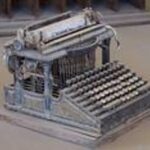Most writing is rewriting, revising, and editing. That’s the eternal truth of the craft. We come to writing in hopes to sit in front of our computers and pen great novels, but we get bogged down in trench warfare. We have great ideals, but spend our time battling misspelled words, flat characters, and dead-end plots. For the inexperienced writer-one who has written a few rough drafts but has not yet kicked off the revision process-years can be wasted learning the basics of editing through trial and error. It takes practice and hard work to become good, and it must be done. Great writers are great rewriters, revisionists, and editors.
By reading this article, you will learn how to skip many of those years of seemingly pointless trial and error; to go at your rough drafts with the same determination you go at the blank page.
Whether you write novels or short stories, in order to revise, you must first have a rough draft. If you don’t already have work to edit, there isn’t much point reading on. There are so many important tools to know about writing itself that you’re wasting your time learning about revising. So get your manuscript (ms) and get ready, we have work to do!
Breaking up your story-whether it be novel or novella or short-is the easiest way to keep the entire product manageable. Ever hear the saying “biting off more than you can chew?” Taking on an entire novel can be a daunting challenge, but if you break a 100,000 word ms into fifty short 2,000 word blocks, and focus on one block at a time, you can manage even the largest works.
If you write on your computer, as I do, it’s very easy to break your ms up. Just save each block into another word document and save it within a folder near your original, whole ms. It’s your choice to work with however large a chunk you want. You can tackle five hundred words at one time or five thousand.
Along with breaking your work into smaller, easily chewed pieces, you should make copies of your original ms along with each additional draft you go through. Save your work in case you must go back to an earlier version. Don’t use the original rough draft to make your second draft changes.
Use the copy for the second draft. Likewise, don’t revise your third draft on your second draft, but on the second draft’s copy. You will find yourself with a lot of copies, but as time progresses and you become satisfied with the work you’re doing, you can delete the earlier ones (but never the rough draft).
Before you begin the editing process, you should have a detailed game plan; a list of goals you want to accomplish with each draft of your ms. Write down what you want to accomplish in the second draft, the third draft, and so on. Use what you will learn here to create your list and remember that it is flexible and changeable as you proceed. The goals will add focus and precision to your editing. Like breaking the work into smaller bites, goals will make the entire revision/editing process simpler and easier to tackle.
***
Three quick tips before we begin:
1. Use Microsoft Word’s highlight ability to further simplify the process. You can highlight text you want to rewrite, delete, or relocate. You can highlight words or complete chapters. Mark what each color stands for (red may mean to delete while yellow means to rewrite). Another tool you can use is the strikethrough. Anything you wish to delete, you can strikethrough so you don’t have to get rid of it until you’re completely finished. Just highlight the text, right click your mouse, and go to font.
2. To gain objective perspective before revising, you can take time off between finishing the rough draft and revising the second draft. Take as much time as you feel you need, but not so much time that you lose your feeling for the work. A month can be a good amount of time, not too long and not too short, for enough objectivity to cut the emotional attachment to your work.
3. Try to stay consistent when revising. Work a certain amount each day, and try to schedule your days so you work at the same time. You can do as little as five hundred words or just a few pages, but stay on task and do that amount everyday. This will keep you in the story and help you finish faster than you would if you worked casually.
***
Start big and finish small; the best way to revise/edit your work. Your first few drafts should be concerned with macro-revisions. The big pieces of the story should be worked on first-story, plot, characters, setting. There is a lot of work to macro-revising, but fortunately this is the easiest part of the editing process, the part that takes the least focus, though the most creative talent. Being hunched over your computer screen meticulously searching each word, even letter, for mistakes comes later. Now we must go over the generalities that make readers happy.
Check over your chapters, your story, to see if everything is in the right order. Sometimes we write a chapter in a certain place when it may work better after or before several other chapters. Read through your ms and make sure the story itself is kosher, and if not, change it around. You can also take this time to add to the story, building up scenes that you only summarized before, and deleting scenes that do not add to your story. At the end of your second draft, you should have added all the necessary parts to your ms, and taken out anything that detracts from the story, anything that seems like a detour from the actual plot.
Make sure all of your characters are the way you want them. Questions to ask are: Are any characters flat? Do any characters act outside their character? Do any of them do things that real people just do not do? Rewrite your characters so that they fit the story and each other and act within their world. Change what characters you need to change, including their names, appearances, and personalities.
Simplify your point of view. Read your ms carefully and make sure the reader will see your story through the eyes of one, consistent character, or a group of characters that you deem important enough to help tell the tale. Make the POV itself consistent. If you begin in first person and end in third person, rewrite the novel to be either all in first person or all in third so you won’t confuse the reader.
Use the macro period to work on description, adding in what you lack or taking out what seems redundant or overdone.
Make sure the structure of your story is sound, that you have the appropriate number of hooks and cliff hangers, and the other things that excite your readers and keep them reading (drama, action, and even short lolls that give the reader a break from constant excitement). Go through the story and revise the pace of the story. You don’t want long periods of rest and then long periods of drama or action. You want to keep the tempo changing but consistent. Too much of the same thing gets old. Keep the readers on their toes by rearranging the flow every four or five thousand words if you can.
***
The fine details of any story, long or short, are more important than the large pieces. An agent or publisher won’t even read your story if you can’t get the micro aspects of your work done correctly. Once you are done with the big pieces, you can start on the small ones.
Why start big and finish small? You don’t want to keep going back between the two. You don’t want to edit the grammar in a story just to go back and rewrite your characters. You’ll have to go through the grammar and punctuation several times, and this can get exhausting. Starting big and finishing small simply allows you to get the most done in the least amount of time, ensuring you will get the entire ms revised and edited and not give up on it.
This is the part where you have to focus on little bits of your story, seeking a divine perfection in your writing. Line editing consists of reading each line of the story and looking for grammar and punctuation mistakes, misspelled words, and misused words.
Stylistic changes come in the micro-editing process. By taking out overly used words, excessive dialogue tags (he said is better than he said contemplatively), prepositions, and “to be” verbs, you can cut many unneeded words and help the reader read faster, with less effort.
Use this time to put each sentence into the active voice. Strong writing, strong verbs, and not relying on nouns to carry your sentences but on action verbs that push your story along, keeps the reader’s interest without burning them out on poor writing.
When you are finished, go over your ms at least once more-two or three times if you feel up to the challenge. Double check your goals to make sure you really are finished. It’s never too late to change something until you’ve mailed your manuscript.
Have as many drafts as necessary to complete your revisions. If this means you have fifteen drafts, don’t fret. Fifteen drafts will make your story perfect, and perfection is what agents and publishers look for. Perfection is also what readers look for, and books with many obvious mistakes do not sell. And remember, most writing is rewriting. It’s always going to be trench warfare, but the war doesn’t have to be long and tedious. If you can learn to enjoy revising you can go far as a professional author.



